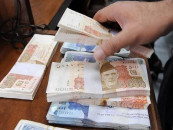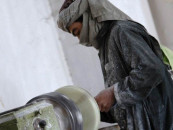Electricity prices: Power tariff hikes linked to efficiency improvements
IMF and government agree to formula on energy pricing, govt agrees to 2% increase in power tariffs.

Pakistan and the International Monetary Fund have come to an agreement on power tariffs, with Islamabad agreeing to an increase in rates, linking promised price hikes to improvements in the efficiency of the national electricity grid.
Sources familiar with the negotiations told The Express Tribune that the government has agreed to a 2% increase in power tariffs from June, as part of an agreement reached with the IMF in March, when the government agreed to raise the prices of electricity in the country by an average of 6% before the close of the fiscal year ending June 30, 2011.
Discussions between the IMF and the government focused much of their attention on the inefficiency of the electricity grid, caused by theft and line-losses. It was agreed that the government would link further increases in prices to its attempts to improve its efforts to mitigate those losses.
According to a government analysis, the government’s average price for electricity that it charges consumers is about Rs1.65 per unit (kilowatt-hour), or 15%, less than the cost of production. The average cost of production is Rs9.56 per unit whereas the average consumer price is Rs7.91 per unit.
About half the difference is accounted for by line losses, which are often factored into the cost of production by power generation and distribution companies. If the government lives up to its agreement with the IMF, power tariffs will rise by about 8% over the next fiscal year, while eliminating nearly all of the difference between production costs and billing rates of electricity.
The IMF has also repeated its long-standing demand from the government to amend laws to provide the National Electric Power Regulatory Authority (Nepra) the mandate to revise power tariffs without having to seek approval from the water and power ministry. It is unclear when the government will implement this proposal.
Over the past three years, the government has tried several measures to reduce inefficiencies in the power sector. There has been talk of privatising some of the nine electricity distribution companies in the country, all but one of which are state-owned.
The government has made at least some progress in its efforts to close the gap between production costs and power company revenues. At the beginning of fiscal year 2011, the difference between power generation costs and billed rates was Rs3.25 per unit, which is now down by 49.2% to Rs1.65 per unit.
At the beginning of the year, the Rs3.25 per unit differential between cost and revenue would have required government subsidies worth Rs256 billion to fill the gap.
Through their efforts to narrow the difference, government officials claim to have spent only Rs140 billion this year in power subsidies. This number is lower than a government budget strategy paper which targeted spending Rs184 billion on power subsidies and an agreement with the IMF to restrict subsidies to Rs153 billion.
Among the measures taken by the government to achieve that narrowing of the gap was a decision to shut down some of the most inefficient power generation plants, especially those with efficiencies of less than 30%.
The government also raised some tariffs, but has been unable to curb inefficiency at the distribution stage of the power chain. Power distribution companies remain as inefficient as ever and have been unable to effectively combat theft and line-losses.
Power subsidies for the coming fiscal year are expected to be much lower than the outgoing fiscal year, owing to a sharply lower deficit target agreed to between the government and the IMF. The budget deficit for fiscal year 2011 is expected to exceed 6% of the total size of the economy whereas the target for 2012 is 4% of GDP.
According to a government analysis carried out by the energy wing of the Planning Commission, the lowest end of power tariffs generates revenues 40% below the production prices and is financed by charging higher end user more for their power usage, a policy known as a ‘cross subsidy’.
The study recommends a rationalisation of price slabs and ending cross subsidies. It is unclear whether the government will implement those recommendations.
Published in The Express Tribune, May 19th, 2011.



















COMMENTS
Comments are moderated and generally will be posted if they are on-topic and not abusive.
For more information, please see our Comments FAQ